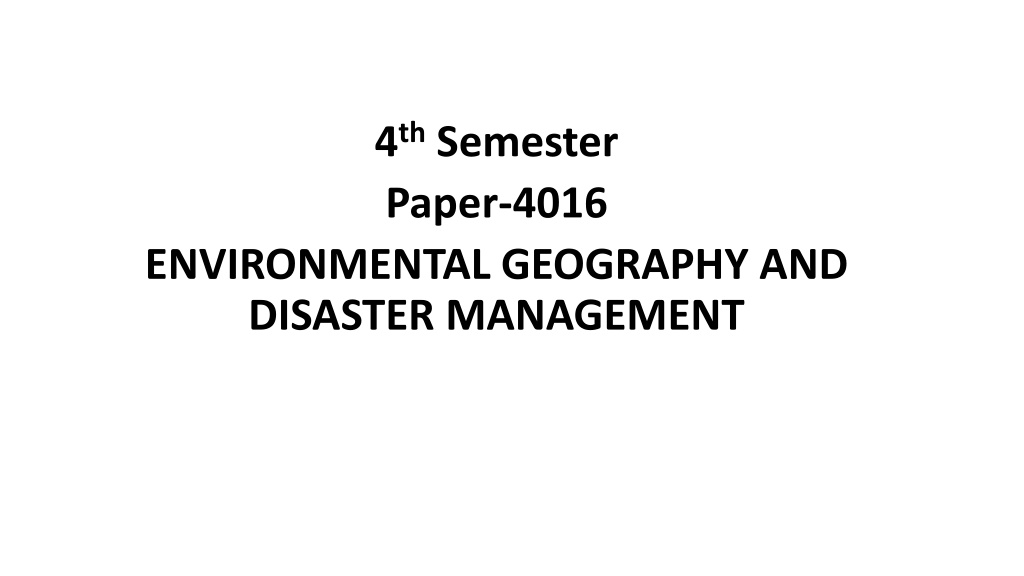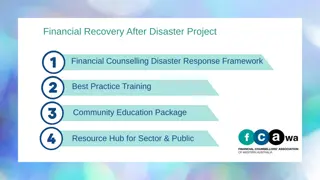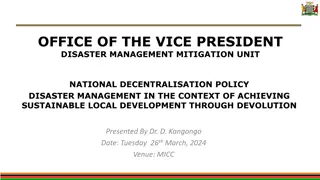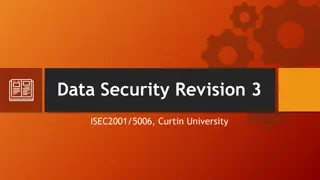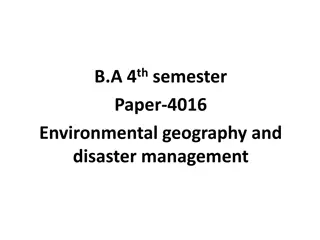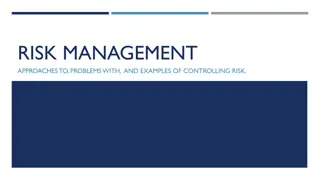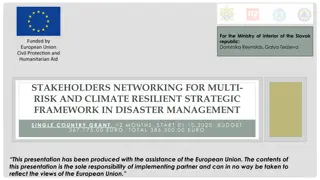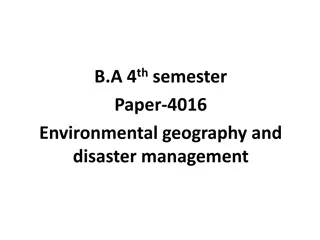Understanding Risk Management in Environmental Geography and Disaster Management
Risk management in environmental geography and disaster management involves assessing the potential losses from hazards, evaluating vulnerability and exposure, and implementing strategies to mitigate risks. It includes calculating risk, dealing with risk through acceptance, avoidance, reduction, or transfer, and focusing on risk mitigation to minimize impacts and costs of disasters. Vulnerability plays a key role in determining how susceptible a community or system is to hazards. Intersection of hazard, exposure, and vulnerability helps in determining overall risk. Effective risk management requires thorough risk analysis and assessment to inform decision-making for risk reduction.
Download Presentation

Please find below an Image/Link to download the presentation.
The content on the website is provided AS IS for your information and personal use only. It may not be sold, licensed, or shared on other websites without obtaining consent from the author. Download presentation by click this link. If you encounter any issues during the download, it is possible that the publisher has removed the file from their server.
E N D
Presentation Transcript
4thSemester Paper-4016 ENVIRONMENTAL GEOGRAPHY AND DISASTER MANAGEMENT
*RISK Risk (or more specifically, disaster risk) is the potential disaster losses (in terms of lives, health status, livelihoods, assets and services) which could occur to a particular community or a society over some specified future time period. (Reference UNISDR Terminology) It considers the probability of harmful consequences, or expected losses (deaths, injuries, property, livelihoods, economic activity disrupted or environmentally damaged) resulting from interactions between natural or human induced hazards and vulnerable conditions. Risk management is a way of preparing a community by employing measures to minimise impacts, and preparing them to cope with impacts. This includes planning to minimise impacts, well prepared emergency plans and measures to protect the most vulnerable people of the community.
Risk can be calculated using the following equation: Risk = Probability of Hazard x Degree of Vulnerability. There are different ways of dealing with risk, such as: Risk Acceptance: an informed decision to accept the possible consequences and likelihood of a particular risk. Risk Avoidance: an informed decision to avoid involvement in activities leading to risk realization. Risk Reduction refers to the application of appropriate techniques to reduce the likelihood of risk occurrence and its consequences. Risk Transfer involves shifting of the burden of risk to another party. One of the most common forms of risk transfer is Insurance.
Risk management Risk mitigation (i.e. moderating the severity of a hazard impact) is the main objective of risk management. It aims to reduce the physical and economic impacts of an event and limit the human, material, economic and environmental costs of an emergency or disaster. Therefore, it is necessary to have good information on the costs of natural disasters. These are estimated with a risk analysis. Following the risk analysis, the risks are evaluated in a risk assessment process to decide whether they are tolerable/acceptable. Both risk analysis and assessment are normally part of an integrated risk management process and produce crucial information that is relevant to decision makers for identifying viable options for risk reduction.
Intersection of hazard, exposure, and vulnerability yields the risk (Reese & Schmidt 2008, p.5)
*VULNERABILITY Vulnerability describes the characteristics and circumstances of a community, system or asset that make it susceptible to the damaging effects of a hazard. There are many aspects of vulnerability, arising from various physical, social, economic, and environmental factors. Examples may include: poor design and construction of buildings, inadequate protection of assets, lack of public information and awareness, limited official recognition of risks and preparedness measures, and disregard for wise environmental management.
Vulnerability varies significantly within a community and over time Physical Vulnerability may be determined by aspects such as population density levels, remoteness of a settlement, the site, design and materials used for critical infrastructure and for housing (UNISDR). Example: Wooden homes are less likely to collapse in an earthquake, but are more vulnerable to fire. 2. Social Vulnerability refers to the inability of people, organizations and societies to withstand adverse impacts to hazards due to characteristics inherent in social interactions, institutions and systems of cultural values. It is linked to the level of well being of individuals, communities and society. It includes aspects related to levels of literacy and education, the existence of peace and security, access to basic human rights, systems of good governance, social equity, positive traditional values, customs and ideological beliefs and overall collective organizational systems (UNISDR). Example: When flooding occurs some citizens, such as children, elderly and differently-able, may be unable to protect themselves or evacuate if necessary.
3.Economic Vulnerability:The level of vulnerability is highly dependent upon the economic status of individuals, communities and nations The poor are usually more vulnerable to disasters because they lack the resources to build sturdy structures and put other engineering measures in place to protect themselves from being negatively impacted by disasters. Example: Poorer families may live in squatter settlements because they cannot afford to live in safer (more expensive) areas. 4.Environmental Vulnerability: Natural resource depletion and resource degradation are key aspects of environmental vulnerability.
It can be best explained by Disaster Risk = Hazard Vulnerability/Capacity The relationship between these four components, indicate that each of the three variables that define risk - the hazard, the elements exposed and their vulnerability are of equal value. Reducing any one or more of the three contributing variables will lessen the risk to a community. In reality, however, there is little opportunity to reduce the hazard component, therefore, only the vulnerability and the elements at risk will vary. When hazard and vulnerability are high, it will cause disaster but when capacity is present, it will decrease the impact. Hence, to reduce the risk of a disaster, 1) Decrease the vulnerability of the community; and 2) Increase the capacity of the community
TERMINOLOGIES UNDRR-United Nations Office for Disaster Risk Reduction It was formerly UNISDR(United Nations International Strategy for Disaster Reduction) REFERENCES/SOURCE *Environmental geography,Savindra Singh *Environmental geography,R.C Chandna *Websites-Office of Disaster preparedness And Management(Govt. Of the Republic of Trinidad)
